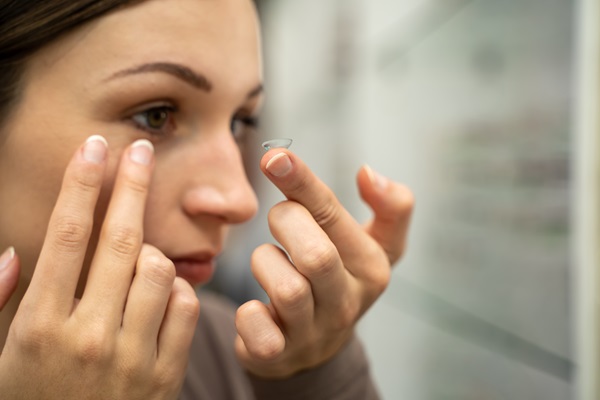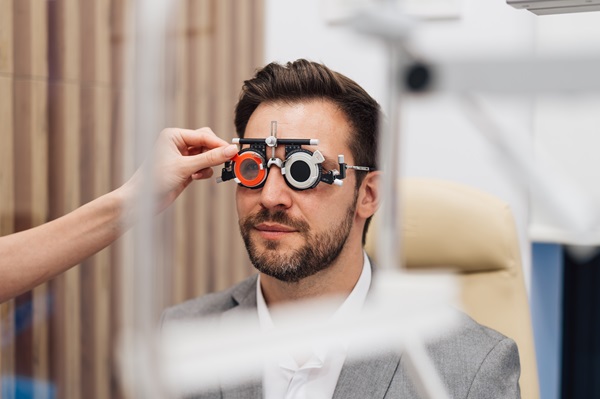Consult Your Optometrist About Prescription Safety Glasses

Long gone are the days of choosing between clear vision and eye protection. Safety glasses are available to all who need them, whether working in a factory, landscaping, or playing sports. Here is what you can expect when consulting our optometrist for these glasses.
What to expect during a safety glasses appointment
Eye exam
No matter the reason one needs safety glasses, patients will require an eye exam. The optometrist will perform a series of tests to measure visual acuity, refraction stability, visual field, eye coordination, intraocular pressure, and each eye's internal and external health. These checkpoints are all necessary to determine the correct prescription for each eye.
Visual acuity
This test is what patients think of when visiting the optometrist, as it measures their ability to identify objects clearly. The test involves using an eye chart and having the patient stand at a distance to read each row, consisting of a series of letters or numbers. This portion of the eye exam will identify refractive errors such as nearsightedness (myopia), farsightedness (hyperopia), or astigmatism.
Refraction stability
This check is more for children, but certain muscular conditions in older patients can warrant the optometrist checking the patient's stability. However, this will not be the case for every patient.
Visual field
A visual field test helps identify vision loss or abnormalities resulting from diseases such as glaucoma or general retinal problems. This includes focusing on specific points in the room as the optometrist places an object like a pen or finger in the patient's peripheral vision.
Eye coordination
The optometrist will test the eye's muscle control and how well they work together. This often includes covering one eye at a time and using a prism to assess the eyes' alignment and movement. This test can uncover conditions such as strabismus or amblyopia (lazy eye).
Intraocular pressure
Though not involved in every patient's eye exam, the optometrist may check the intraocular pressure. It is a simple test involving the optometrist gently pressing around the patient's eye and its surface. This test, formally referred to as tonometry, is painless and conducted to determine if the eye pressure is normal or if further testing is necessary.
Internal and external eye health
Finally, the main aim besides determining a prescription for the safety glasses is to determine the eyes' overall health. The optometrist will assess the external structure of the eyes, including the eyelids, lashes, and conjunctiva-- looking for signs of abnormalities or infection. They will then complete the exam using various machines to check the health of the retinas, optic nerves, and blood vessels.
Choosing frames
After the eye exam, patients will not have to wait for their exam results. The optometrist will review their findings and suggest an appropriate course of action. If there is evidence of a disease or eye condition, the optometrist will review best practices while wearing the safety glasses.
Next, the patient will be able to choose their frames. This choice should be made carefully with patients considering why they need these glasses, the frequency with which they will wear them, and the duration of each use. Safety glasses are usually not meant for 24/7 wear. Even though frames have similar styles, they will not fit the same and consist of different materials. Therefore, we strongly encourage trying them on. We encourage patients to let us know if the frames we have in the office are not fitting. We can provide the prescription for the patient to consider online options.
It is important to know that no matter if the patient chooses an in-office or an online pair, there will be a waiting period for their prescription lenses to be crafted and attached to the frames in an offsite lab. Our typical waiting period is around two weeks before our office receives the glasses. At that time, we will contact the patient to pick up their glasses and try them on to ensure a good fit, and no other adjustments to the prescription are necessary.
Checkups
Prescriptions can change, as can the health of one's eyes. That is why the American Academy of Ophthalmology recommends adults aged 20 to 39 receive an eye exam every two to three years if they are in good health. However, if they are 39 or older or receive prescription glasses, their annual checkup should be conducted. Of course, the frequency of eye exams will vary for each patient depending on their medical history, familial history of diseases, and existing vision problems.
Schedule an appointment
Receiving safety glasses is a simple process, only requiring one appointment—two, if you count picking up your glasses. If you require safety glasses, contact our Dallas office to schedule an appointment.
Request an appointment here: https://www.texasoptical.net or call Texas Optical at (214) 771-7333 for an appointment in our Dallas office.
Check out what others are saying about our services on Yelp: Read our Yelp reviews.
Recent Posts
A contact lens exam is slightly different from an eyeglass prescription exam. Though both correctives are great for helping you see clearly, contact lenses can be a better fit for certain individuals, such as those who live more active lifestyles. Take a closer look at what you can expect during your upcoming examination.A general eye…
Regular eye exams are crucial for maintaining overall health for people of all ages. By establishing a relationship with an optometrist, you not only protect and enhance your vision but also safeguard against potential health issues. This comprehensive guide highlights the benefits of maintaining a connection with our office, a practice that benefits everyone in…
Your eye health is an essential part of your overall health. Regular checkups with an eye doctor can often prevent many eye issues and complications, catching them in their early stages. Here are three key signs that it might be time to visit an eye doctor.Eye discomfort can appear in many ways. While occasional eye…
Proper vision care can address eye strain and reduce its uncomfortable symptoms. An optometrist will also help to prevent future eye strain. Thus, while there are many ways to strain your eyes, there are many changes you can make to give them a break.Straining the eyes can bring all sorts of symptoms. As a result,…


